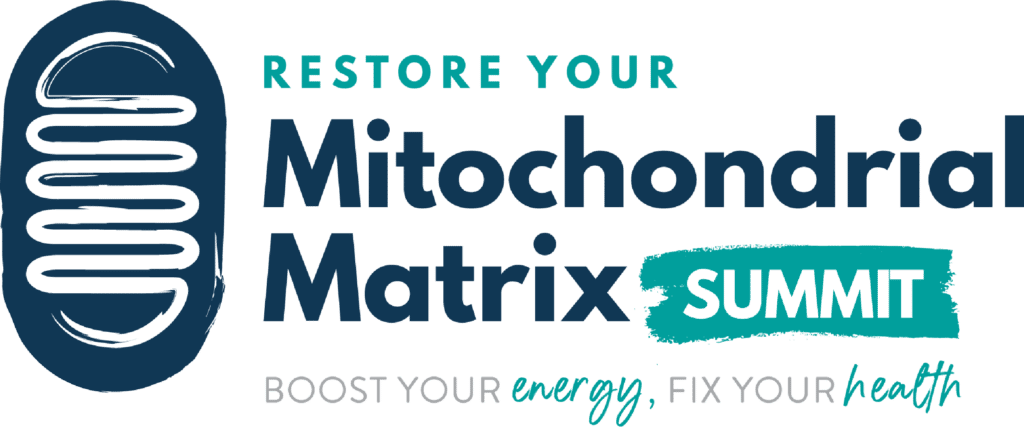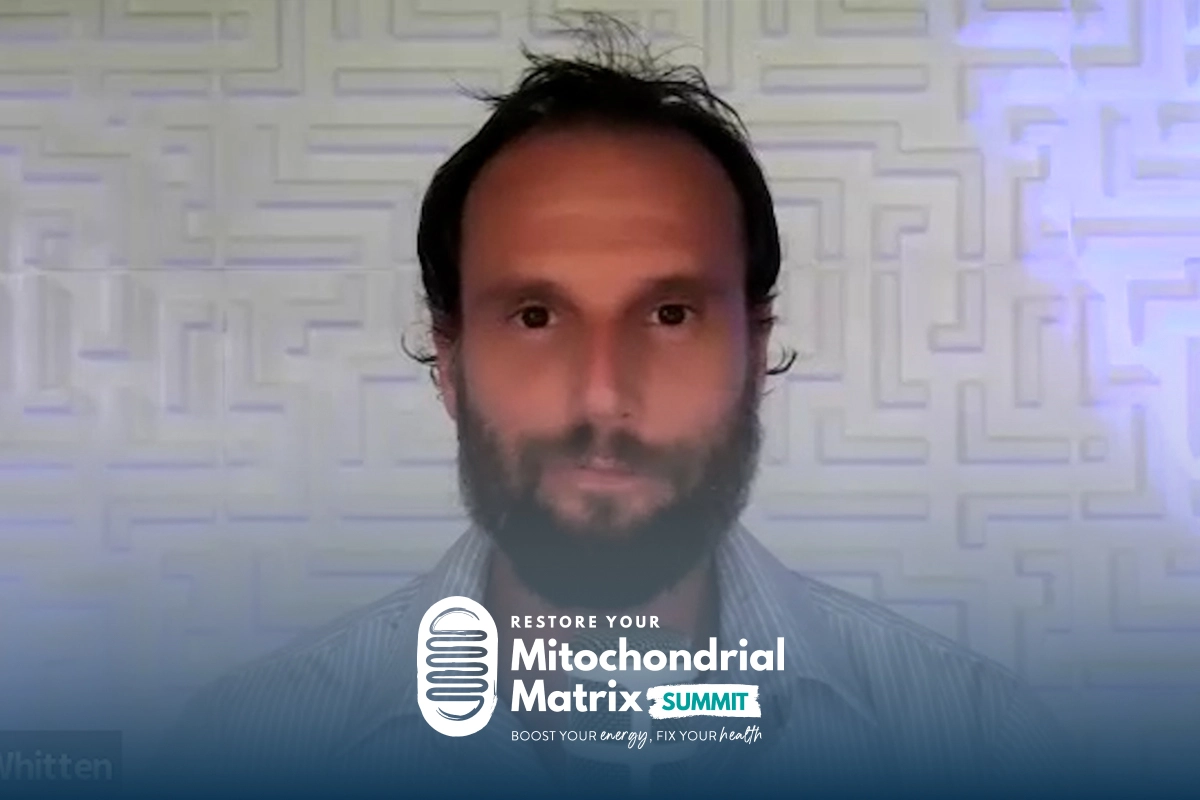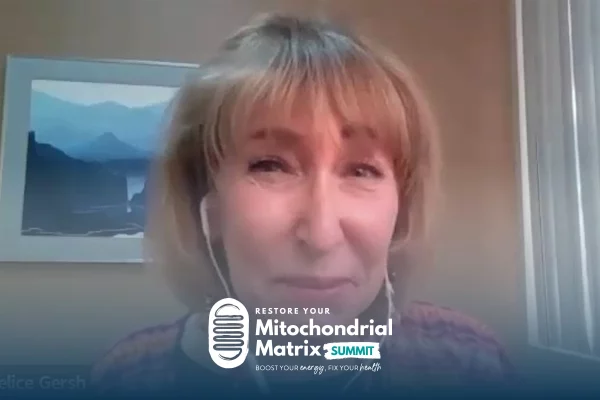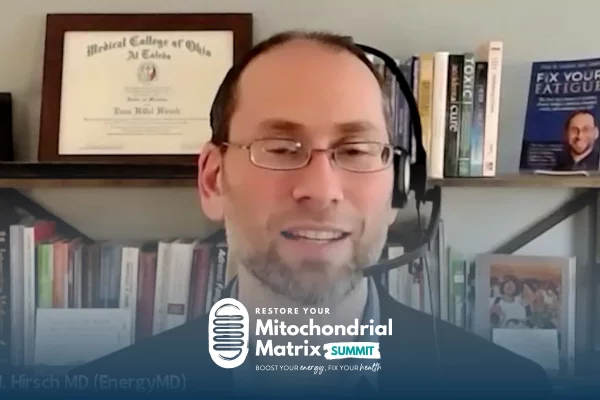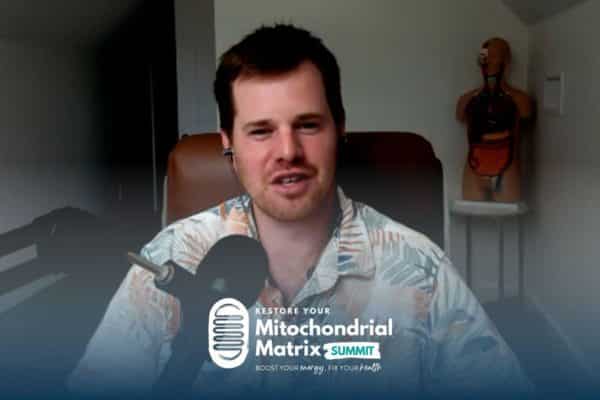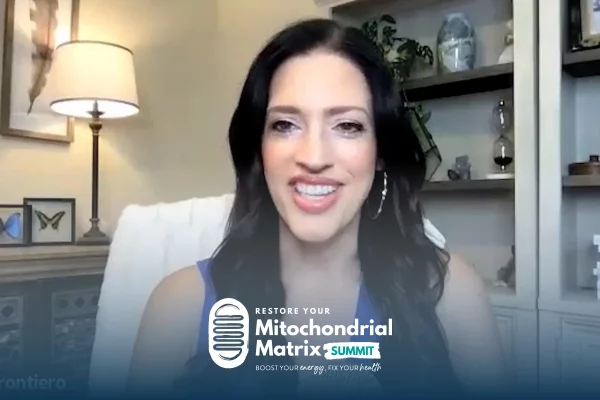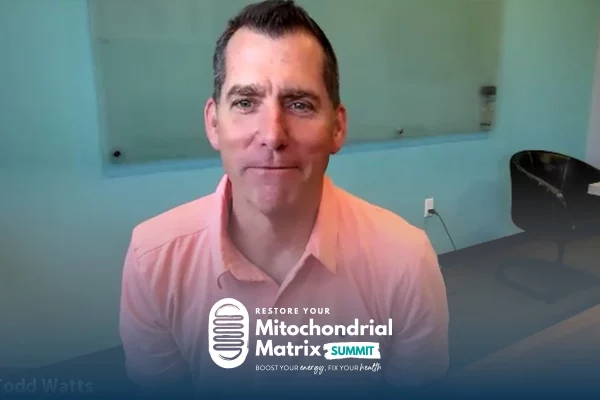Join the discussion below
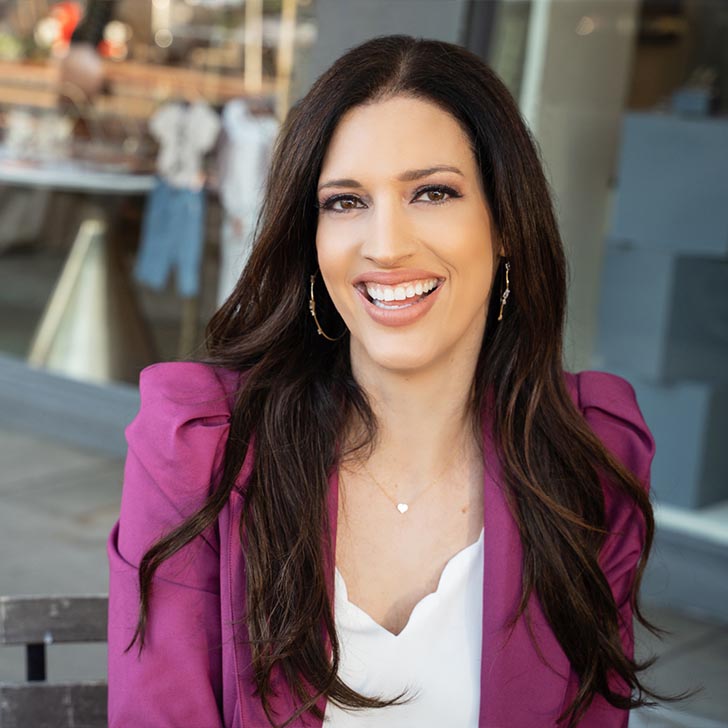
Laura Frontiero, FNP-BC, has served thousands of patients as a Nurse Practitioner over the last 22 years. Her work in the health industry marries both traditional and functional medicine. Laura’s wellness programs help her high-performing clients boost energy, renew mental focus, feel great in their bodies, and be productive again.... Read More
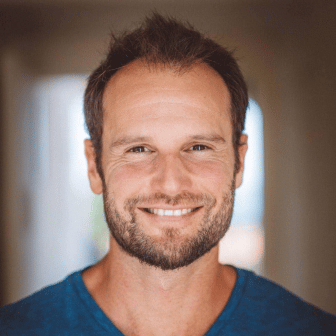
Ari Whitten, MS is the founder of The Energy Blueprint. He is the best-selling author of The Ultimate Guide To Red Light Therapy, and Eat For Energy: How To Beat Fatigue, and Supercharge Your Mitochondria For All-Day Energy. He’s a natural health expert who takes an evidence-based approach to human... Read More
- Learn why most people lose 75% of their mitochondria with age, and how to PREVENT this from happening to you
- Understand how to grow bigger and stronger mitochondria (and even reverse the aging process by making MORE mitochondria from scratch)
Laura Frontiero, FNP-BC
Welcome to another episode of the Restore Your Mitochondrial Matrix Summit. I’m your host, Laura Frontiero, and I’m bringing you experts to help you boost your energy and fix your health so you can build the life you love. And today my special guest is the esteemed Ari Whitten. Hi Ari, welcome to the summit.
Ari Whitten, PhD Candidate, CES, PES
Thanks so much for having me, Laura. Pleasure to be with you.
Laura Frontiero, FNP-BC
Oh, it is. You know, I couldn’t host a mitochondria summit without having one of the world’s most well known mitochondria experts as a featured speaker. So you can imagine how happy I was when you said, “Absolutely, I will come and teach and talk on this summit and share my knowledge.” So thank you. And I wanna introduce you to our audience. Hopefully everybody watching pretty much knows who you are, but just in case you’re new to Ari. Ari, you’re the founder of the Energy Blueprint System and it’s a comprehensive lifestyle and supplement program. And here’s the astounding thing you’ve helped more than 2 million people and counting.
I don’t think there’s anybody on this summit that can say they’ve touched 2 million people so far in these interviews. This is an extraordinary. And you really have helped them build, you know, optimal health, better performance, more energy. You’re the best selling author of the Ultimate Guide to Red Light Therapy and the host of the popular, The Energy Blueprint Podcast, which by the way, is like an education in itself. Like I listen to your podcast just to learn and hone my own skills. It’s like going to school really. It’s like going back to college, it’s like continuing education. And you really have featured the world’s leading natural health experts.
We can find your podcast programs and supplement formulas at theenergyblueprint.com and one more thing, you have a new book that just came out, “Eat for Energy,” and this is how to beat fatigue, supercharge your mitochondria and unlock all day energy. So this is super exciting. And we’re gonna dig in here. We’re gonna talk all about the role mitochondria play in producing and enhancing your energy. But real quick, before we get into that, can you just tell us, how did you get here? Like what, where did you come from and how did you end up landing here? Because I know you were talking about mitochondria before it was even popular to talk about mitochondria.
Ari Whitten, PhD Candidate, CES, PES
Yeah, actually there’s a lot there. First of, I wanna say thank you for all the kind words you just said. We should just conclude the interview right now after that. I think it’s all gonna be downhill from here with that kind of intro. So yeah, it is true what you just said that I was talking about the central role of mitochondria in energy long, really long before anyone else. And while everybody else was still talking about adrenal fatigue, I was out there debunking adrenal fatigue and taking a lot of flack for it. And people were trying to attack me for it and saying, oh, this guy doesn’t know what he’s talking about. Da, da, da, da, da. Now it’s widely accepted within the natural health and functional medicine community.
Everybody’s kind of like, oh yeah, adrenal fatigue isn’t really a thing, that that’s kind of pseudoscience and really it’s more about the mitochondria. I’m like, yeah, well, I was saying that like a decade ago when you guys were attacking me for it, you know. So yeah, and the short version of my story is, you know, I’ve been studying health science since I was a little kid, since I was 12 or 13 years old and I’m 38 now. This is a lifelong passion and obsession for me. And it was a kind of the first 10 years was all about fitness and fat loss and muscle building and bodybuilding and athletic performance and that whole world. And then in my mid 20s, I got Epstein-Barr virus. I got severe Mononucleosis that left me severely fatigued for almost a year.
And I kind of watched as my life and everything about my life, my relationship with my girlfriend, friendships, I was in school at the time, I was working a job at the time, like a very hard manual labor job and everything in my life kind of deteriorated and fell apart as my energy went down the drain. And that was really the big catalyst that made me interested and obsessed with the science of human energy and what actually controls it. And then I, you know, spent many years digging into the science around adrenal fatigue and then kind of realizing, oh, all these people talking about adrenal fatigue, don’t really know what they’re talking about. Conventional medicine doesn’t really have anything to offer people with chronic fatigue. And that was kind of the big catalyst. The big experience for me that made me go– kind of let go of all the world of bodybuilding, body composition, athletic performance stuff, and shift all of my focus towards the science of human energy levels.
Laura Frontiero, FNP-BC
And focus your energy you did. Because not only did you become a leading authority and expert in this and really bring it to the functional and integrative medicine in the communities that we both are a part of when people weren’t talking about it, you were. But not only that, you created your own supplement, you’ve written books about this. You have a leading podcast. So tell us a little bit about how you came to being a supplement formulator, and how you ended up going in that direction to support mitochondria health.
Ari Whitten, PhD Candidate, CES, PES
Yeah, well, I was initially white labeling supplements, which is something that’s very common. A lot of people do that in our space. A lot of our friends and colleagues and there’s nothing necessarily wrong with it. However, it basically creates an additional middleman. So financially, so that the customer ends up, you know, paying a pretty heavy markup to cover the profit margins of everybody involved. And when I was going through, you know, all the different supplements, I was recommending to people with chronic fatigue to sort of rebuild their health and their mitochondria. It ended up being, you know, a recommendation that was like $500 a month, you know? And so I obviously I’m sensitive to that.
I don’t wanna be out there pushing supplements onto people that are ridiculously expensive, such that, you know, people have to, I mean, 70% of the population lives, month to month, they don’t have $500 extra each month. And, I was also dealing with the fact that even with that, I was still limited cause certain of the ingredients that I wanted weren’t even present in that supplement stack that I was re recommending. There was 15 different bottles of stuff that I was asking people to take every day. And then some of the ingredients weren’t dosed at the proper effective dosages. And so I just, I had all of those problems, but there’s also the massive convenience of white labeling, you know, just slapping my brand’s label on somebody else’s supplements. I don’t have to do any of the formulation, manufacturing, all of the headaches, that big cash flow problems, right? All of these business problems that you have with creating your own supplements. But at a certain point I just said, you know what, I can create something better. And I really want to dedicate myself to creating the best in category supplements, especially for mitochondria. I want to create the best mitochondrial formula on the market bar none.
And I also do things in a way that no one else really is willing to do what I’m doing because from a business perspective, it’s so dumb. Basically my expenses to give you some insight in sort of the business aspect of doing supplements. Most people make supplements where the cost for them is somewhere between like $3 to maybe $12 on the high end per bottle. My costs are typically five to 10 times more expensive for all the supplements I create because I’m using, you know, what most supplement manufacturers do even if they have an impressive list of ingredients is they’ll put, you know, they’ll have Ashwagandha on the label and Rhodiola and this vitamin and this mineral and Spirulina and Chlorella and whatever else. And that looks impressive to the person who isn’t familiar with the research on those compounds.
But what they’re doing is they’re taking a compound that should be dosed at a 1000 milligrams or 3000 milligrams and they’re putting in 50 milligrams of it or 150 milligrams. They’re putting in 1/20th, 1/10th, 1/5th, the actual effective dose that has been shown in research to work and to provide benefits. So the way I do things is I actually, I put in five, 10, 20 times more of these ingredients so that I’m actually giving the effective dosages. But the downside of that is from a business perspective, on my end, it costs me astronomically more than what most other supplement manufacturers are doing.
So my profit margins are way, way smaller. And I have to rely basically on educating the consumer on the difference between dosing Spirulina at 50 milligrams versus 2000 milligrams, right? And just as one example of 80 examples, but yeah, that’s sort of fundamentally what drove the whole thing is I wanted to create a supplement that didn’t just make me money and is yet another one of the millions of supplements that people buy and take based on hype and promises and big claims and then they notice nothing from it. I wanted to create supplement formulas that people actually go, wow, this actually transformed my health, this transformed my brain function and my energy levels. So, you know, that’s fundamentally the goal. And I work through the business challenges to be able to do that.
Laura Frontiero, FNP-BC
I’m so glad that we just had the opportunity to talk about this because Ari, you know, my experience of you is the guy who takes the high road, who swims upstream, who does the thing that maybe nobody else is doing. And I’m sure at the end of the day, you lay your head down with absolute peace of mind, knowing you gave your best. You did your best. You’re helping absolutely the best possible way that you can. So I just wanna acknowledge you for that. And with that, I think that sets the stage for your authority on what we’re about to talk about now that everyone listening says, wow, I trust this guy. This is amazing that he’s doing this. So thank you for explaining that.
I don’t think most people understand what the supplement industry is actually like and how unregulated it is and how crazy it is. And I mean, people just on a side note all the time when I’m asking people to take a supplement and they’re looking at the bottle and they said, but you’re telling me to take so much more than it’s in here. It’s like, that’s right, because what’s on that label is not a therapeutic dose. And based on your labs and your symptoms, that little tiny dose is not going to help you. You’re literally wasting your money. So yeah, we gotta give you higher dosing. So that’s really important. So thank you for sharing that. All right, so we’re gonna dive in and we’re gonna talk, you know, we have a lot of people talking about why that mitochondria produced 90% of the bodies energy, but we don’t have a lot of talking about how mitochondria control whether or not to produce energy. So I wanna get, you have like a deep, granular knowledge of this. So can you speak into that a little bit? So we know mitochondria produce energy. But talk a bit more.
Ari Whitten, PhD Candidate, CES, PES
Yeah, so you teed up, you teed that up for me very nicely. So the way we were all taught about mitochondria in high school and college biology courses is they’re the powerhouse of the cell quote unquote. And the way that they’re typically taught about is basically as these sort of mindless energy generators, they just take in the carbs and fats that we consume and they pump out energy in the form of ATP, Adenosine triphosphate and it’s true, of course, that they are our cellular energy generators. And as you said, they provide virtually all of the energy for virtually all of the trillions of cells in our body, from our brain, to our liver, to our intestines, to our muscles, to our hormone producing glands, pretty much everything. The exception of like red blood cells, for example, don’t have mitochondria, but 99% of the cells in your body do. And that role as energy generators is incredibly important of course.
And if they’re not producing enough energy for one reason or another, and there are a few reasons why they might not be, then the function of all of those tissues that are depending on mitochondrial energy production suffers. So if it’s your brain, you start to get brain fog. You might have depression and anxiety, which have been linked with mitochondrial dysfunction. You might have other brain related symptoms, brain related fatigue, things like that, difficulty concentrating. If it’s your heart, you can have cardiovascular problems. You can have problems with fitness. Same if it’s your muscles, you have similar problems. If your hormone producing glands are there, the mitochondria there are not producing energy adequately, then you’re probably gonna not have optimal levels of hormones. There are many, many different consequences of that. So this role in energy generation is incredibly important, but here’s the part that has not been well understood. Because what most people think of when they think of mitochondria is again, these mindless energy generators.
And basically what we have to do to get our mitochondria functioning is take a bunch of, you know, Acetyl-L-Carnitine and CoQ10 and B vitamins and a Alpha-lipoic acid and voila or mitochondria can function better, except it’s not quite that simple. And the reason why is that mitochondria actually have a second role that has only been discovered really in the last decade or so. We’ve known about mitochondria for about a hundred years, but it’s only in the last 10 that it’s the science, some specific researchers like Robert Naviaux, who runs a lab for mitochondrial medicine at the University of California, San Diego have built out an understanding of mitochondria as something more than just mindless energy generators. And this second role that they have is actually as environmental sensors, mitochondria are essentially like the canaries in the coal mine of our body.
And they’re constantly taking samples of the environment of what’s going on in the body. And they’re basically asking the question, are we under attack? Is it safe to produce energy? And what this means in other words, is mitochondria essentially have a dual role. They can either be in energy mode or defense mode where they’re orchestrating a shift of the cells’ resources towards defending against a threat. Now those two roles are mutually exclusive. So to the extent they are picking up on threats and dangers that are present in the body and they can pick up on virtually every type of stressor, you can think up, from poor nutrition, to poor gut health, to psychological problems, to psychological stress I should say, to sleep deprivation, to environmental toxicants, to light deficiencies and toxicities to you name it.
Basically every type of stressor those mitochondria can sense. And to the degree on pathogens, I should also mention viruses, obviously, given what’s been going on in the world last couple years. To the degree that they are sensing the presence of threats or stresses present, they turn down the dial on energy production and shift resources towards cellular defense. So our energy levels are fundamentally a reflection of the degree to which our mitochondria are either in energy mode or defense mode.
Laura Frontiero, FNP-BC
And this is really important. And I wanna make sure that we really highlight this. So I think most of us would think, okay, I’m under attack by an infection of some sort of virus, a bacteria. Therefore, my body should be producing more energy for my immune system, for nutrient absorption for, you know, hormone production. But what you’re saying is when that infection hits, we might actually down-regulate energy production. Tell us why.
Ari Whitten, PhD Candidate, CES, PES
So think of it like a bear in a harsh winter. Does a bear respond to harsh environmental conditions by going, I’m gonna ramp up my engine so I can produce more energy so I can have even more energy to go scour for food and dig everywhere in the snow and try and dig up something I can eat? Or does it go, I’m gonna turn down the engines and maybe hibernate during the harsh environment period? Okay, and in fact, it’s not just bears that do that, many other species of animals and this is actually widespread, including all the way down to microscopic creatures, round worms and Tardigrades, which are ubiquitous in water everywhere these little microscopic water bears, they look like little bears, but they have six legs. And they are known to in response to harsh environments, whether it’s extremes of heat or cold or pressure or anything like that, toxicants they basically go into a state of like dormancy.
They’re not quite dead, but they’re not quite alive. And then as soon as the sort of the sensors pick up that the environment is safe again, they turn the engines back on. So this response is ubiquitous in nature and it makes sense. It makes a lot of sense because if you think like, let’s imagine you and I are in a war zone right now. Let’s imagine that we’re in the Ukraine, for example, and all we’re sitting in a house and all of a sudden the Russians attack, and they put poison gas in the streets and we see that, you know, filling the air of the streets. It would be a terrible mistake for us to go you know, it looks like a lovely day outside. Let’s go about our business as usual. Let’s open the windows, let the fresh air in, let’s go for a walk outside in the park, right? What you do when you’re under attack is you seal yourself off.
You don’t go about business as usual. You seal yourself off, you shut things down and you potentially invest resources into defending against that threat. Maybe you call 911 and say, hey, they’re attacking, hey, there’s poison gas over here. Call the cleanup crew. Let’s get this fixed, right? You don’t go for a walk outside and leave the windows open. So this makes sense. And if all of that isn’t compelling enough for you think of the last time that you got a cold or a flu or COVID. Did you have more energy or less energy, right? One of the classic symptoms of having an infection is fatigue. And this is part of the intelligent response of our body, mostly orchestrated by mitochondria. Also, we have another mechanism that helps facilitate it as well, which is called sickness behavior. And there’s a lot of research on this term. It’s actually, that’s a scientific term called sickness behavior, and it’s partly regulated by the brain as well in response to elevated levels of inflammation.
The brain basically senses again, kind of we’re under attack. There’s either an infection present or a toxic exposure or an injury of some kind. That’s why we have these elevated levels of inflammatory cytokines and in response to that part of the brain is basically orchestrating a turning down of the engines, such that you have what’s called sickness behavior, which is symptoms like lethargy, apathy, and depression, and, you know, lack of drive and motivation and energy, basically. How do you feel when you’re very sick, right? You wanna lay on the couch and not do much, that’s sickness behavior. So, yeah, so it’s mostly orchestrated by mitochondria, but also the brain is involved to some degree as well.
Laura Frontiero, FNP-BC
Can you talk about one more thing? So we’re talking about cell danger response here.
Ari Whitten, PhD Candidate, CES, PES
Yes.
Laura Frontiero, FNP-BC
And there’s one more piece that I think is really important. And it’s the fact that the mitochondria also are shutting down energy so that the invader doesn’t get to use the energy themselves. So can you talk a little bit about that? Because of that, here’s where my mind’s going. When, you know, with COVID I had COVID, I was so exhausted and afterwards, you know, we’re studying, we’re learning about COVID. And so many people are saying, you’ve gotta support mitochondria, you gotta support mitochondria. And it sounds to me like, yes, that’s important, but it also sounds to me like my body did exactly what it was supposed to do that complete exhaustion. And I think of it, like when we launch a fever, we really don’t want to suppress that fever. We wanna let it go until it hits a point where it’s dangerous, right? And then maybe we suppress it a little. So it almost seems to me like that fatigue is part of the healing process and I’m trying to wrap my brain around it, but talk about that energy kind of steel that interactions do.
Ari Whitten, PhD Candidate, CES, PES
Yeah, so yeah, there’s a number of layers to this. I’m glad you brought this up, but let’s go back to the sickness behavior I was just talking about, so let’s say from, in an evolutionary ancestral context, you got injured by an animal or you know, fell down the side of a cliff or something. Your body’s all scraped up or you have a broken bone, something like that. You’re gonna have increased levels of inflammation. And that are associated with the injured tissue. That injured tissue will recover much faster if you allow it to rest rather than to continuing to use it aggressively, right? So that’s part of the, you know, there is an intelligence behind this mechanism. It’s adaptive. It’s not a mistake. Similarly, if you have a cold or a flu or COVID like, or something like that, and you say, I’m gonna go work out as I normally do, I’m gonna go for my five mile run right now.
Well, if you do that, you are likely to suppress immune function and make the infection much worse. So again, the resting, the sickness behavior, the fatigue is actually an intelligent adaptive response built into us by millions of years of evolution. In the context of a pathogen, as you said, there’s also a concern of the ability of some of these pathogens to actually use our ATP, to help basically stimulate this, their growth and their spread and, you know, their process of infecting us, basically. There’s another aspect to it, which is mitochondria are actually part of the innate immune system. And they are not only organizing and sort of, you know, sensing the presence of a pathogen and sort of helping to communicate to the rest of the body, to that there’s a problem that needs to be addressed and so the immune system gets involved, but the mitochondria themselves are actually part of the innate immune system.
And this is likely why just as a side note, why children typically fight off COVID much, much easier than older adults do. Their innate immune system is way stronger. Their mitochondrial networks are way stronger. So the mitochondria actually start intentionally producing lots more free radicals. They become less efficient at producing energy so that they can throw off more reactive oxygen species and free radicals with the intention to actually damage any pathogen that might be present in the cell. So that’s part of our immune defenses is actually to sort of kill anything that might be present in the cell by the mitochondria producing energy, less efficiently, and throwing off more free radicals.
Laura Frontiero, FNP-BC
Wait, wait. So you’re saying we can’t demonize all free radical production. You’re saying, how did you put it that this is an intelligent adaptive response?
Ari Whitten, PhD Candidate, CES, PES
Yes and actually there’s a lot more to that story if you want to dig more into that and kind of.
Laura Frontiero, FNP-BC
Sure, I mean, we’re just going wherever we go here. And I think, you know, if people are really paying attention here, this is mind blowing. This is literally turning upside down everything you think you know about what you’re supposed to do with energy production and when you’re sick. And I mean, we’ll get into how to support your mitochondria here and what you recommend. But I think unpacking this is really key.
Ari Whitten, PhD Candidate, CES, PES
Yeah, so I agree totally. Here’s another cool layer to the story I always like when this comes up in interviews. It was thought for many, many years, you know, kind of people were operating in this simple paradigm. And I would actually still say, there’s a huge chunk of people still operating in this paradigm, even though it’s been very thoroughly debunked in the research, still a lot of people are unaware of it. Basically the paradigm is free radicals are bad. Antioxidants are good. And there’s a long history here. There’s something called the Free Radical Theory of Aging by a researcher named, I forget his first name, but Harman was his last name. It’s often called in literature, Harman’s Free Radical Theory of Aging. It was a very popular theory of the aging process to explain why we age for decades.
And it was extremely well studied and at the end of it, basically, there were lots of experimentation, experiments that essentially proved the theory wrong. Here’s an interesting aspect. Well, there’s two layers to this story that are very interesting. One is you can do experiments where you give lots of antioxidant supplements and you see if it extends lifespan, you give people lots of, or animals, lots of vitamin C and vitamin E and vitamin A and things like that. And you see if it reliably extends longevity and the vast majority of those studies show, the answer is no. On the other hand, there are many studies where they use methods that increase free radicals. As an example, exercise increases free radicals, creates a big spike in reactive oxygen species. But there are other ways of doing that too. Heat stress, cold stress, hypoxic environments, certain kinds of.
Laura Frontiero, FNP-BC
Intermittent fasting.
Ari Whitten, PhD Candidate, CES, PES
Intermittent fasting, certain kinds of phytochemicals and a number of others, even weird things like radiation and so on have been studied in animal models and they create a big spike in free radicals. But when they’re applied in the appropriate dose, they actually extend lifespan. So something which increases free radicals extends lifespan. Okay so those are the two lines of evidence that ultimately sort of debunked this Free Radical Theory of Aging, but there is something to the theory and I’ll get there in a second. So one of the other interesting things is maybe about 15 years ago, there were a number of researchers who basically sought to study exercise and they basically said, well, we know exercise is amazing. It has all these incredible benefits. It helps lower the you know, and prevent many different types of diseases, cardiovascular diseases, lung diseases, brain diseases, all kinds of different diseases.
It’s so beneficial. But the big problem with exercise is that it creates a whole bunch of free radicals, these damaging free radicals. So what if we do the exercise, but we give people antioxidant supplements before or after or before and after the bout of exercise to neutralize all those reactive oxygen species, then we can get the benefits of the exercise without incurring the harms. And they did those studies and they found something remarkable that they didn’t expect. The antioxidants canceled out the metabolic benefits of the exercise. So basically what has been discovered since then is what we now know is that reactive oxygen species, as you said, are not all bad. And in fact, they are vitally important signaling molecules for mitochondria. And what they do is they signal the mitochondria to adapt to that stressor. So in the same way that if I lift a heavy weight and I do a bunch of bicep curls, I may temporarily incur damage and inflammation to that tissue, but I’m stimulating my body’s intelligent adaptive response that makes it go well, how can I adapt to that stimulus to better survive it, to better tolerate it, to be more resilient, to suffer less damage from it, and the way that it does that it builds more muscle fibers to grow stronger.
So the same exact principle applies internally at the mitochondrial level. When your mitochondria are challenged by stressors, which create a spike in free radicals, those reactive oxygen species actually signal the mitochondria to adapt to the stressor by growing stronger. And they do that through a few different mechanisms. They physically grow bigger and stronger. There’s a pathway called the Nrf2 pathway that’s directly stimulated by reactive oxygen species. And that triggers the internal what’s called the ARE, the Antioxidant Response Element, which is our internal supply of antioxidants, which is orders of magnitude more important than any external antioxidants we might supplement with. And that includes things like glutathione and catalase and superoxide dismutase.
And it makes that system much more robust so that it can be much more resilient to a broad range of, to not only that stressor, that exposed to, but to a broad range of other stressors. And it stimulates something called mitochondrial biogenesis, the creation of new mitochondria from scratch. So you’re literally building bigger, stronger mitochondria, more mitochondria, and up-regulating, you’re basically charging up their internal antioxidant defense system so they’re capable of neutralizing oxidative stress and toxins from a broad range of other stressors. And that’s fundamentally why exercise and sauna use and cold stress and basically all the other types of hormetic stressors work too. Even though they create a spike in free radicals, they are actually extending lifespan and making us more resistant to stress.
Laura Frontiero, FNP-BC
This is so interesting. What comes to mind while you’re explaining all this, this age old phrase that we all know, whatever doesn’t kill you makes you stronger. And that’s what I keep hearing in my head as you explain this, I get, you know, I’m thinking to myself, okay, it was tough having COVID. I had long symptoms for a while, and you know what, I’m stronger for that. I’m stronger for that. Like everything that we go through. And even when you’re doing that hard push with exercise, or there’s times I’ve been in the sauna where I’m like, I’m gonna die. I cannot be in here for two more minutes, but I’ve gotta stay in here for two more minutes. And you have that feeling like I can’t do this. And when you get on the other side of it, you actually just created strength in your mitochondria in your body. So remember what it doesn’t kill you, it makes you stronger.
Ari Whitten, PhD Candidate, CES, PES
Absolutely and I’ll add one layer to that, which just to point this out. There is the physiological effect of the stressor. Let’s say, being in the sauna and what is the heat actually doing to your physiology, to your mitochondria. And there is simultaneously a mental aspect. You’re getting psychological hormesis at the same time. And when you take that attitude that you were just describing into it, of pushing yourself into the discomfort, you actually become stronger mentally, too. There’s such a thing as mental hormesis and we can become, we can train ourselves to become mentally tougher. And we can do it in the context of something that is also making us physiologically more resilient at the cellular level at the same time.
Laura Frontiero, FNP-BC
‘Cause everything’s connected, right? That’s so good. All right one more thing. I mean, I could talk to you for hours and we can’t have an hours long interview, but there’s one more piece that I would love for you to touch on because it’s not easy to find information on this. And that is the connection between your mitochondria and your gut health. And I find that people don’t talk a lot about that, right? We talk about the mitochondria being highly concentrated in the brain, in your heart, in their liver and all these vital organs. And somehow, I don’t know if there’s just isn’t a lot of research on the gut in mitochondria, or if it’s just not understood, but I know that you know, something about that.
Ari Whitten, PhD Candidate, CES, PES
Yeah, so, you know, the gut is connected to pretty much everything. And I would say the thing that gets more publicity is more widely known is that there’s a gut brain access. And you know, there’s a ton of research around that. What goes on in the gut has a huge impact on brain function, neurotransmitter levels, how much inflammation is in the brain and so many other aspects. There’s also a gut skin access, a gut lung access, a gut immune access and there’s a gut mitochondria access. And there’s plenty of research on this. And we know there’s a lot of different layers to this, but we know actually from research done on those with people with chronic fatigue syndrome, that they have consistently lower bacterial diversity, and they have higher amounts of bacteria that are associated with endotoxin producing bacteria, which are lipopolysaccharide, it’s basically a type of toxin that’s on the bacteria themselves.
So certain types of bacteria that have this toxin people with chronic fatigue have more of it. And they have lower amounts of bacterial species that are involved in producing beneficial metabolites, like short chain fatty acids, things like butyrate, for example, which is not only its self involved in promoting gut health, but also is critical to this gut mitochondria access. So the butyrate actually goes to the mitochondria where it’s utilized sort of preferentially to produce energy. So it’s part of what helps mitochondria produce energy efficiently and abundantly. And if you have a microbiome in your gut that is deficient in that, you’re now deficient in short chain fatty acids and so your mitochondria are going to not produce as much energy. This is so well defined in the literature that there’s one study that’s kind of mind blowing.
They actually used a computer program with an algorithm to analyze those differences in the microbiome between healthy people and those with chronic fatigue syndrome. And they found that purely based on microbiome analysis, no other biomarkers whatsoever, no blood tests, no hormones, no nothing else. Purely based on gut microbiome, they can detect with 90% accuracy who has chronic fatigue syndrome. So that tells you, you know, that the gut is playing a pretty massive role in this issue. So, you know, fundamentally what’s going on is various kinds of toxic exposures, combination of poor diet, psychological stress could even be things like physical overtraining. Though that’s not the main cause for most people it’s more like poor diet, alcohol consumption, antibiotic use, other kinds of prescription drugs and toxic exposures, sleep deprivation and psychological stress, some mix of those kinds of variables ultimately sort of disrupts the microbiome diversity and causes some of those changes in the microbiome that I just mentioned that in turn affects the integrity of the gut lining and then you start to get increased intestinal permeability, and then you start to get undigested food particles leaking into the bloodstream causing uncontrolled inflammation, which is sensed by mitochondria as a danger signal that they shift out of energy mode and into defense mode in response to.
There’s also some from that LPS, the endotoxin on that bacteria, now you have LPS leaking into the bloodstream as well. And this is called endotoxemia in the research. This has been linked with chronic fatigue, decisively. It’s also been linked with many other diseases, neurological diseases, cardiovascular diseases, obesity, diabetes, things like that. And the endotoxin, the LPS itself is also causing damage directly to mitochondria. So, you know, that’s part of the elements of what’s linking the gut to the mitochondria is you have now toxic elements that are either directly damaging mitochondria or are acting as dangerous signals causing the mitochondria to turn down energy production and shift towards cellular defense. I mentioned earlier kind of this ancestral context of this intelligent adaptive mechanism of mitochondria to turn down energy production and shift into cell defense.
If you’ve got an injury or an infection like an acute injury or an acute infection, this is completely a very, very intelligent response to respond this way. But if you now have a chronic source of inflammation, whether it’s from chronic, if you have poor gut health and now you’ve got chronic endotoxins leaking into your bloodstream and undigested food particles, if you’re overweight, you’ve now have adipokines, inflammatory cytokines constantly being produced by the excess body fat itself. You have insulin resistance, constantly creating hyperglycemia, which is also damaging the mitochondria. We, in the modern world, we have these constant trickles that never end of danger signals to our mitochondria. So we’re constantly shutting them down and forcing them to respond to threats. So the gut is a huge piece of that. One other piece that I’ll mention as far as gut health that’s really cool is some of these bacterial species are critical for transforming certain compounds. So they’ll take certain phytochemicals from the foods that we eat and transform them into other molecules that have certain effects on the mitochondria creating like an active metabolite that is active in a different way than the original chemical from the plant.
One of the best examples of this is Ellagic acid. There’s a compound in certain foods. It’s not found in a whole lot of foods. It’s found in small amounts in certain berries. And it’s found in much larger amounts in pomegranates and chestnuts. And this Ellagic acid gets converted by specific species of bacteria in our gut into a compound called urolithin A and urolithin A it turns out is basically the most powerful promoter of Mitophagy that’s ever been discovered. Mitophagy is basically, if people have heard the term autophagy this is autophagy at the mitochondrial level. So this is basically our quality control process for mitochondria, where every night we want to be breaking them down. The ones, the mitochondria that are dysfunctional and have damaged parts in them. We want to be identifying those, chemically digesting them and rebuilding new, healthy mitochondria every night. And that’s related to what’s going on in our gut, our ability to do that depends on producing the right metabolites in the gut. So the mitochondria can get those signals to do that well.
Laura Frontiero, FNP-BC
So it’s so deep and so complex, you know, throughout this talk, you’ve touched on many different things we can do to optimize our body nutrition, how we can support our mitochondria. So, as we talked, you spoke about, or hormetic behaviors to stress the mitochondria. You’ve talked about the importance of gut health and clearing up leaky gut. I mean, if you’re reading between the lines, that’s imperative in order to fix mitochondria health. And now you’re talking about eating things like chestnuts and pomegranates, which, I mean, who eats those, they’re so inconvenient, right? So somehow we need to get that. So what else are you gonna, what else can you give our audience as we wrap up? Because we do have to close this interview, unfortunately, I don’t want to, but we have to, and we have to give people some more titbits of what are the things they can do to optimize their nutrition, their energy production. What else would you suggest?
Ari Whitten, PhD Candidate, CES, PES
Oh, so much. One thing I’ll mention just to I would say probably my favorite topic is hormetic stress. And I wanna just maybe tie some loose ends here and then I’ll end with like a bit of practical advice. So I like to think of fatigue and energy as having two fundamental things that control it. One is what’s happening at the environment and lifestyle level. So what are you eating? What kinds of, what are your light exposures, your, you know, daily movement habits, your level of psychological stress and your habits around de-stressing, your circadian rhythm and sleep habits, your degree of toxic exposures and so on? That’s one big thing. And in response to that total body stress load, that’s the degree to which your mitochondria are going to either be in energy mode or defense mode. But there’s another big key to this story.
And that is what is happening inside of your cells? What is the status of your mitochondria inside of your cells? And what I mean by that is it’s possible to have cells filled with tons of big, strong, robust, healthy mitochondria, and lots and lots of them, or it’s possible to have cells filled with small, weak atrophied mitochondria and very few of them. And to give you some specific numbers, it’s been shown in research where they, I love this type of study. It would actually be a very useful type of diagnostic test if they integrated this into clinical practice, but it’s painful and most people don’t wanna do it.
They take a big hollow needle and they jab it into your thigh and they pull out a chunk of muscle and like a biopsy needle and they put the tissue under a microscope and they literally count the number of mitochondria in the cells. And it’s been shown in several studies that on average mitochondrial capacity, the number of mitochondria per cell declines by about 10% with each decade of life, such that the typical 70 year old has only about 25% of the mitochondrial capacity as a young adult. They lose 75% of their mitochondrial capacity. Now what’s, you know, people listening to this might think, well, that really sucks that we lose so much of our mitochondria as we age. Here’s the good news. When they look at 70 year olds who are lifelong athletes and exercisers, they have the same mitochondrial capacity as a young person. So what this means is the loss of mitochondria is not a normal product of aging.
It’s a product of lack of hormetic stress in your life. This is what determines whether your cells have very few mitochondria or lots and lots of big, strong, healthy mitochondria. So if I could emphasize one thing, I would say ramp up the amount of hormetic stress in your life and really emphasize that and integrate other types of hormetic stressors that you’re not already doing. Sauna is incredible. Exercise is of course incredible. There’s many different subtypes of exercise. They all have their unique sort of hormetic fingerprint as far as adaptations, they stimulate. Sauna is amazing, breath hold practices are amazing for stimulating mitochondrial adaptations and many other types of adaptations in the body.
So I would say really focus on building and stimulating mitochondrial biogenesis, rebuilding healthy amounts of mitochondria in your cells by using hormetic stress. And I would say in particular, one really powerful way for people with chronic fatigue is breath hold practices and exercise often tends to be really draining and fatiguing for people with chronic fatigue, breath hold practices are something that you can do to really give your mitochondria a big adaptive stimulus, but without actually draining your energy stores by, you know, taxing your energy system so much. So that’s one thing I would highly encourage people to experiment with.
Laura Frontiero, FNP-BC
So good. So some simple things that people can do and of course get a hold of your book because.
Ari Whitten, PhD Candidate, CES, PES
Definitely.
Laura Frontiero, FNP-BC
Help you with nutrition and eating. And I bet you, I mean, I’ve just barely started reading this now ’cause it just came out and I just got it. But I bet you there’s a whole bunch of other tips in here even beyond eating for energy, right?
Ari Whitten, PhD Candidate, CES, PES
It’s… that book in particular is basically all nutrition.
Laura Frontiero, FNP-BC
Wow.
Ari Whitten, PhD Candidate, CES, PES
So it’s, you know, I’ve been studying nutrition for like 20 whatever, six years, 27 years. That book is basically the distillation of everything I know about nutrition as it relates to ramping up energy levels and mitochondrial health. Tons of good stuff. Yeah.
Laura Frontiero, FNP-BC
Yeah. The references and the end notes in this, I mean, it’s literally like a quarter of the book. There’s so much research.
Ari Whitten, PhD Candidate, CES, PES
Yeah. I had somebody write a review on Amazon the other day that said, like she was a nurse and she came into this book super skeptical that it was gonna be just another bunch of fluff and pseudoscience, like most diet books. And she’s like, I’ve never seen a book with a 1000 references where it takes up, you know, half the book, just all the list of references. She’s like other than a textbook, other than my textbooks, I’ve never seen a popular diet book like this so.
Laura Frontiero, FNP-BC
That’s what I’m saying. Your stuff is like continuing education for practitioners and health providers. Ari, we’re very appreciative and you teach in such a way that the health consumer can understand it as well. So you make it really easy for everyone to understand. So thank you.
Ari Whitten, PhD Candidate, CES, PES
Thank you so much. Thank you, I appreciate it.
Laura Frontiero, FNP-BC
Yeah, it’s been an absolute pleasure having you on the summit. Thank you so much for your time and for your generosity, really, to the planet, to the world, to humanity.
Ari Whitten, PhD Candidate, CES, PES
Thank you so much. You’re wonderful, you’re a great speaker, a great interviewer and very, very charming and charismatic. I really enjoyed talking to you.
Laura Frontiero, FNP-BC
Thank you, Ari. You take good care. Bye now.
Downloads
